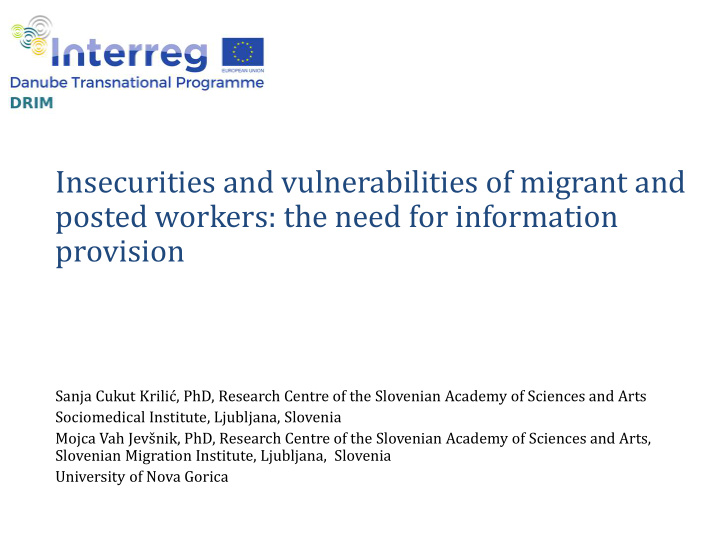



Insecurities and vulnerabilities of migrant and posted workers: the need for information provision Sanja Cukut Krilić , PhD, Research Centre of the Slovenian Academy of Sciences and Arts Sociomedical Institute, Ljubljana, Slovenia Mojca Vah Jevšnik, PhD, Research Centre of the Slovenian Academy of Sciences and Arts, Slovenian Migration Institute, Ljubljana, Slovenia University of Nova Gorica
Posted worker is an employee who is sent by his employer to carry out a service in another EU Member State on a temporary basis . Directive 96/71/EC of the European Parliament and of the Council of 16 December 1996 concerning the posting of workers in the framework of the provision of services October, 2017: Agreement among EU countries: Directive Revision to be transposed into EU law Key: Equal pay for equal work principle Social aspects of posting!
deep political-economic tensions: o liberalisation of the service sector o preserving national labour and social standards Cross-border employment relations often result in precarious working arrangements - inclusion of posted workers into the new system of industrial relations?
- positive discourses on mobility underscore the vulnerability of contemporary forms of mobility - Posted workers – highly mobile, but often without proper rights - Posted workers from third countries – migrants and posted workers: double vulnerabilities!
Occupational safety and health vulnerabilities of migrant/posted workers • layered framework to assess the occupational safety and health vulnerabilities of migrant workers (Sargeant and Tucker; Danaj) 1. the migration factors • conditions of the recruitment (nature of work, contracts, agreement, the migration status of the worker (legal status)
2. Characteristics of the migrants: • socio-economic conditions in the home country – willing to consent to poor working conditions • education and skills levels • language skills – follow OSH procedures and guidelines, attend trainings, etc.
3. receiving country conditions: o the characteristics of employment and sector, o access to collective representation, o access to regulatory protection, o social exclusion/social isolation.
o Work-related accidents and ill health can therefore also be attributed to stress-related conditions – short-term and long-term o hazardous sectors such as agriculture, construction and mining – particular proneness to disease. • Brexit debate: market integration in the absence of social protection: insecurity and marginalisation for growing numbers of European citizens
o Workers ’ role in terms of monitoring and enforcing labour conditions is generally relatively passive? BUT: logical outcome of the temporary and insecure nature of their employment (Berntsen and Lillie). o Transnational action of trade unions important!
o Posting of Workers: Sharing Experiences, Promoting Best Practices and Improving Access to Information (EaSI, PROGRESS/ 2014 - 2016) - increasing the accessibility, transparency and coherence of information on posting of workers for the officials of competent public authorities, employers and posted workers in Slovenia. o Occupational Safety and Health of Posted Workers: Depicting the existing and future challenges in assuring decent working conditions and wellbeing of workers in hazardous sectors (2017 – 2018)
Information and access to information – crucial issues DRIM - Danube Region Information Platform for Economic Integration of Migrants, financed by the Interreg Danube Transnational Programme o transnational cooperation and mutual learning; o create a common, transnational rather than national, information tool for migrants and mobile individuals o Public institutions and migrants/mobile individuals
• Danube Compass information platform • training courses among public institutions, especially national and local authorities that work with migrants • national and transnational workshops with decision makers in the region • country specific recommendations which will serve as the basis for the preparation of the Strategy promoting the access to information as the key integration measure.
CONCLUSIONS o Multisectoral/multidisciplinary activities o heterogeneity of posted workers and their diverse work/life experiences. o Evidence-based strategies/activities
Thank you!
Recommend
More recommend